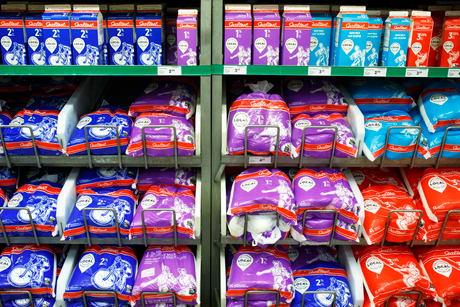
Oh, Canada! As proud Canucks, we certainly have our share quirky traits and tastes, from profusely apologizing with “soar-ee” to our love of ketchup chips, butter tarts and poutine. But did you know that bagged milk is also a uniquely Canadian invention?
Believe it or not, milk bags have been in Canadian fridges since the 1970s, selling mainly in Ontario, Québec and the Maritimes. Each package contains three un-resealable plastic pouches filled with milk, equaling 4 litres total. Insert a single bag into a pitcher, snip off the corner and start pouring. Then put the pitcher back in the fridge, until you need it next.

It wasn’t always this easy. Until the late 1960s, milk was packaged in heavy, breakable glass bottles, racking up big bills for the dairy industry to transport. Soon, alternatives started arriving on the market, such as cardboard cartons, plastic jugs and eventually, plastic bags.
As the story goes, DuPont, a Canadian food and packaging company, unveiled thin, plastic bags that could be used to store and sell milk in 1967. Gradually, the dairy industry began ditching glass bottles and adopting this newfangled plastic pouch, which was far more practical and cost-efficient. Plus, Canada’s conversion to the metric system in the 1970s made the switch a no-brainer: while plastic jugs and cardboard cartons had to be redesigned and manufactured to be sold in metric units, plastic bags could easily be re-sized.
But we’re not the only ones in the world who are rocking the plastic udder. Milk bags can be found in many other countries, such as South Africa, Argentina, Uruguay, Hungary and China. In Israel, there’s a Kankomat: soft, plastic milk bags with a knife built into a plastic container. So when it comes to milk, Canadians may march to the beat of their own drum, but there are many other nations playing alongside in the band.
These days, Canadians are doing some cool things with discarded “milk bladders.” Milkbags Unlimited, a volunteer network across the Greater Toronto Area, recycles milk bags into sleeping mats. Every adult-sized mat is made with approximately 400 milk bags, which are cleaned and cut into strips. Volunteers loop and fit each bag onto a frame, weaving it into the mattress that has a lifespan of approximately 25 years. In addition to the mats, milk bags are also used to stuff pillows and to weave into handbags. The milk bag mats offer a durable and washable alternative to sleeping on cold, damp, and dusty ground, and have particularly helped people living in disaster zones. When resources are scarce, health care professionals have even used these mattresses as substitutes for operating tables. Talk about MacGyver-style upcycling.
Related: The Delicious History of the Halifax Donair
So the next time you snip off the corner of a milk bag, you should feel a twinge of Canadian pride. This may be one of our weird and wonderful national habits, but no one can say that Canucks aren’t resourceful!
Get inspired (and patriotic) in the kitchen with these iconic Canadian foods you can make at home.
